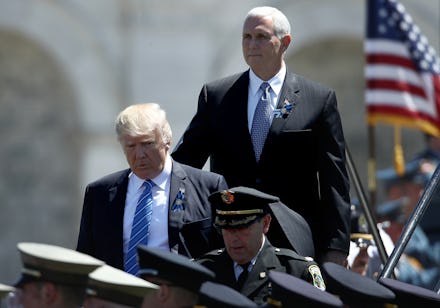25th Amendment: This means of removing a president wasn't created with Trump in mind

In the wake of recent revelations that President Donald Trump revealed highly classified information to Russian officials during their White House meeting, many of Trump's critics are raising the possibility of impeachment.
But the lengthy impeachment process isn't the only way to remove a president from office. There's also the 25th Amendment, a 50-year-old provision that, though untested, could be the key to a swifter transfer of power.
What is the 25th Amendment?
The 25th Amendment explains the transfer of power in the event the president or vice president resigns, dies or is otherwise unable to fulfill the duties of their office. As stipulated by the amendment, the vice president will ascend to the presidency in case of vacancy; when the vice presidency is unfilled, the president must nominate their replacement and have that nomination approved by a congressional majority.
Most relevant to the current administration, however, is Section 4 of the amendment, which allows for a president's own vice president to remove them from office if deemed unfit to serve. The section reads:
Whenever the Vice President and a majority of either the principal officers of the executive departments or of such other body as Congress may by law provide, transmit to the President pro tempore of the Senate and the Speaker of the House of Representatives their written declaration that the President is unable to discharge the powers and duties of his office, the Vice President shall immediately assume the powers and duties of the office as Acting President.
The president, the amendment continues, can resume their duties after providing a written declaration of their ability to do so. If the vice president and executive staff disagree with this assessment, the decision then heads to Congress for a vote. A two-thirds majority of both houses must decide a president is "unable to discharge the powers and duties" of office for the vice president to continue as acting president; otherwise, the president will assume the office once again.
25th Amendment passage and purpose
The 25th Amendment was passed in 1967 in response to the 1963 assassination of President John F. Kennedy, fixing a long-problematic constitutional oversight, according to the National Constitution Center. Though the vice president traditionally became president when needed, there was previously no formal method of filling the vice president's newly vacant position. As a result, the Legal Information Institute noted, there had been no sitting vice president for approximately 20% of U.S. history, as seven vice presidents had resigned or died while in office in addition to those who assumed the presidency.
But that wasn't the only policy the Founding Fathers didn't think to include. The Constitution also failed to stipulate what to do in the event a president became incapacitated — such as President Woodrow Wilson's 1919 stroke, which, according to PBS, led to first lady Edith Wilson leading a "bedside government" shrouded in secrecy that "essentially excluded Wilson's staff, the Cabinet and the Congress."
Because of this, the 25th Amendment created a new system in case such an event were to happen again. The policy was created with the possibility of a stroke, heart attack or other medical complication in mind — not, to quote a Trump advisor in Politico, a president who "doesn't really know any boundaries" or "realize the implications of what he's saying."
In the 50 years since its passage, the president has used the 25th amendment six times to temporarily appoint the vice president to acting president during routine medical procedures, Politico Magazine noted. However, invoking the amendment to oust a president whose mental capabilities are called into question would be unprecedented; the amendment wasn't considered a possibility even at the height of President Richard Nixon's "incoherence" and "irrationality" in 1970.
To use the 25th Amendment to force Trump out of office would undoubtedly be a challenge, requiring the support of both Congress and the executive branch and the willingness to navigate uncharted constitutional territory. But if Vice President Mike Pence and the executive branch want to bring an end to the administration's "chaos" without drawn-out impeachment proceedings, invoking this untested amendment could be worth the risk.